How Does Google Ads Work For Ecommerce Based Businesses?
The aim of this page is to give you a clear understanding of how Google Shopping Ads work. We’ll do this by explaining why certain elements to digital marketing are important and the implications. Clients that are open to learn about Google Ads are more likely to get more confident about their digital marketing.
You can start learning about Google Ads Shopping by selecting the tabs. We have placed the content in the order we feel is best to understand how all the products / websites / Google Analytics / and Google Ads link together.
Who Can Play The Better Shopping Game?
In Poker, there are rules to be followed. There are Excellent Players & Poor Players and the House.
The House takes a cut, the Excellent Players win and the Poor Players lose money.
Google Shopping Ads is very similar to Poker. Google is the House and the players are the Advertisers.
You’ll get Excellent Advertisers and Poor Advertisers.
Whoever can play the better game against the competitors and with the correct resource can now have a chance on Google Ads but all the factors have to be “right”.
Spending lots of money without a clear plan, skills, great website etc means you’re not playing a good game.
At Click Metrics know what “levers” to pull and how to access the outcome with a decision making process.
What is Google Shopping?
Google shopping ads are the sponsored ads usually at the top of the page or on the right hand side of the page, where you see the picture of the product and price. It looks like this:
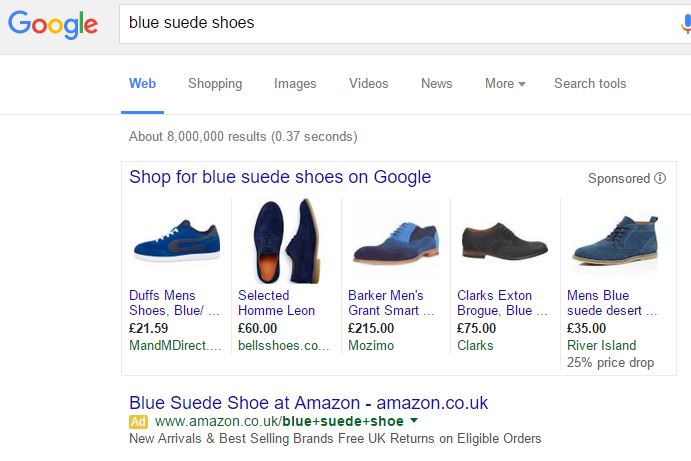
Companies pay Google for each click to drive traffic to their websites. The great thing about shopping ads is it pre qualifies the customer before they click to the website. They get a feel of the product and price before they commit and go to the website. Unlike text link ads where the customer can’t see image or price, shopping ads can help reduce wasted clicks. Better to send a click when the user at least has an idea of what he’s getting.
E-commerce do much better with shopping ads than text link ads because they are getting pre sold before they land on the website.
Question: Can you see how Google Shopping clicks helps pre qualify the customer much more than a text link ads? To use Google shopping, you’ll need a data feed.
What is a Shopping Data Feed?
To get your products listed in the Google ads, you need to submit a shopping feed to the Google Merchant Centre found here: https://www.google.com/retail/solutions/merchant-center/
A shopping feed is a special file or web address which hold all the raw data of your products. It will hold information like the title of the product, pricing, image address, description, etc. Think of it as a file which contains all the raw data of your product which you’ve uploaded to the website.
Depending on your website platform, it can be produced in CSV format, or XML format. Here is what it looks like:
CSV – This data could then be added to a Google Sheet as the data feed

XML – This would be a web address ending .xml to be submitted to Google Merchant Centre
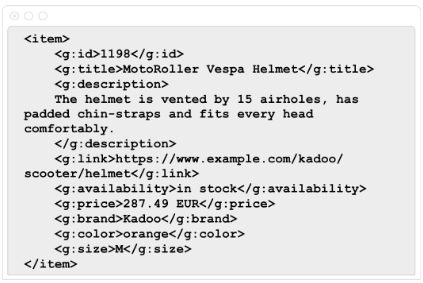
Without the above, you can’t run a Google Shopping campaign.
Question: What website platform do you use? Does it produce Google data feeds? Can you locate it?
What Does Google Shopping Ads Costs?
So assuming you are interested in Google Shopping Ads, I suppose the next question you’re thinking is, “what’s it going to cost me?”
Well question will be split in two parts, the first part is the cost of each click and the second part is the overall budget needed for a campaign. We’ll only cover the first part in this tab.
The answer to the question of cost is…we don’t know. Until we do the research using the tools provided by Google, we’ll be guessing. Google Ads costs vary by industry. Some markets the cost per click or CPC can be as low as £0.05 and some markets as high as £1.50 a click and more.
It just depends what market you’re in and the going rate. What we can do is research and find out what it’s going to cost by finding the cost of each click in Google Ads.
We do this by using a tool provided by Google called Keyword Planner. This tool has been specifically designed for users to research the search volume per month / click costs / competitiveness for a keyword and more. So what does Keyword Planner look like? See below when we research the search volume on Google for the phrase “mens blue suede shoes”
The keyword “mens blue suede shoes” is searched 1,000 times per month in the UK and cost £0.29 on the low side (meaning a very low position in Google, less chance of getting a click) and £0.84 for the top positions with a high chance of a click.
You can access Keyword Planner, sign in with your Adwords account:
https://ads.google.com/intl/en_uk/home/tools/keyword-planner/
Research your own market and find out the cost per click with your search terms. By finding out the cost per click for a keyword, we can now model the type of budget that might be used to give Google Ads a go. In the next tab, we talk about the second part of of costs, which is the recommended budget.
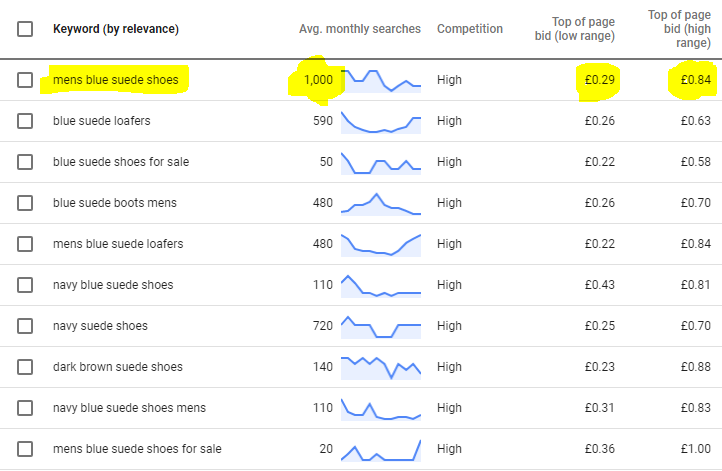
What Budget Do I Need?
Generally speaking, you need enough budget to give you a sizeable amount of data before you make any decisions.
If you were targeting nationwide, you might test with a budget that allows for 5,000 clicks over a period. If your market is local, you might test for 500 clicks. There is no right or wrong answer but generally, the more clicks you get the better the chance to “read” the data.
In our experience we generally test 250-300 clicks (phase 1) before we make our next move. Bear in mind, if the keywords are not correct, then you would have wasted clicks. Literally every options, setting, targeting has to be at optimum level before even doing the first “test” campaign.
Using the “mens blue suede shoes” example of £0.29 and £0.84 a click. We can now model a budget to be put aside for Google Ads.
To model for 250 clicks (assuming the right / targeted keyword) we’ll need a budget of £0.29 x 250 clicks = £72.50. For 300 clicks its £87.
When it gets to £0.84 per click (ie the advertiser wants to be number 1) you’ll need a budget of £210-252. Bear in mind, these are just Google’s suggestions and in most cases, you won’t pay that amount. You can control what you want to pay for the click (Google decides if it want’s to show you). You’re bids can be a max of £0.70 a click.
When bids are high, it usually relative to the job value when a customer is gained.
To wrap up this section and to answer how much budget is needed to give it a fair test:
You test for 250-300 clicks in 3 phases total of 750-900 clicks
Find the average cost per click (CPC) then multiply by 250 clicks
This will give you the first phase budget.
250-300 clicks for any starting campaign (assuming the right foundations, your Google Ads consultant, keywords etc) will give you a good “feel” for the campaign and to make the next move.
All of this doesn’t matter unless you have conversion tracking in place.
Conversion Tracking
So why is conversion tracking important? Well if you’re not tracking it or don’t know how to, you won’t know how efficient your campaign is.
Conversion tracking is the practice of measuring results in a meaningful which has a real impact on the business.
It’s NOT enough anymore to look at the amount clicks Google Ads sent. You want to be looking at the amount of sales that was resulted from Google Ads. This is when your paid search marketing becomes real because its actually quantifying in clear numbers.
Let me make this clear one more time. You MUST know how well your Google ads are performing and you can start asking the right question:
What does it cost my buisness to generate a sale on the website
or
How much % of margin am I willing to give away to Google to bring in a sale?
You should be able to view this in your Google Ads admin and know the costs of a sale etc. You should see a similar table below. The data below shows that its costing £11.89 to bring in one enquiry for the clients business and they had 48 conversions in that 2 month period for the top campaign.
Google Ads stats view with conversion numbers and cost per conversion
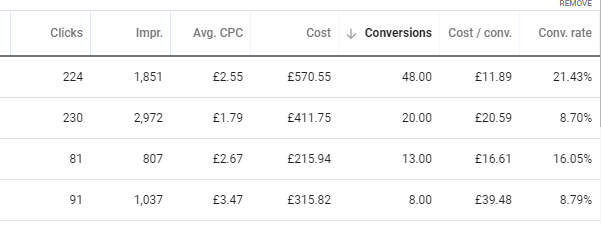
The cost per conversion will be less with an e commerce website but you get the idea. e.g The website sells a pair of shoes for £50 and the cost to bring in the sale was £2.50. The shoes margin was 50% which means profit would be £25-£2.50 which leaves £22.50.
Based on these sample figures, it may make financial sense to run a Shopping campaign.
Until you know what it cost to bring in a phone call / website sale, you won’t know what you’re willing to spend.
When you start knowing these numbers, it allows you to model how the business can grow.
Bear in mind, there are so many elements that will affect the conversion numbers such as the website look, the offer on the website, the keyword used, the cost of each click, the position of the click etc so the topic of conversion is about about knowing numbers clearly.
The topic of conversion tracking is about being ABLE to measure numbers regardless of how good or bad the numbers are. We’ll talk about what is good or bad in the “Modelling ROI” tab.
Question: Are you currently tracking conversions accurately?
In the next section we talk about the type of conversions that can be measured.
Google Analytics Tracking
When running a Google Shopping campaign, your Ads account should be linked up to your Google Analytics account. You should be able to log into your Google Analytics and see sales data with the source / medium on the left hand side showing Google / CPC. This means analytics is tracking Google shopping clicks.
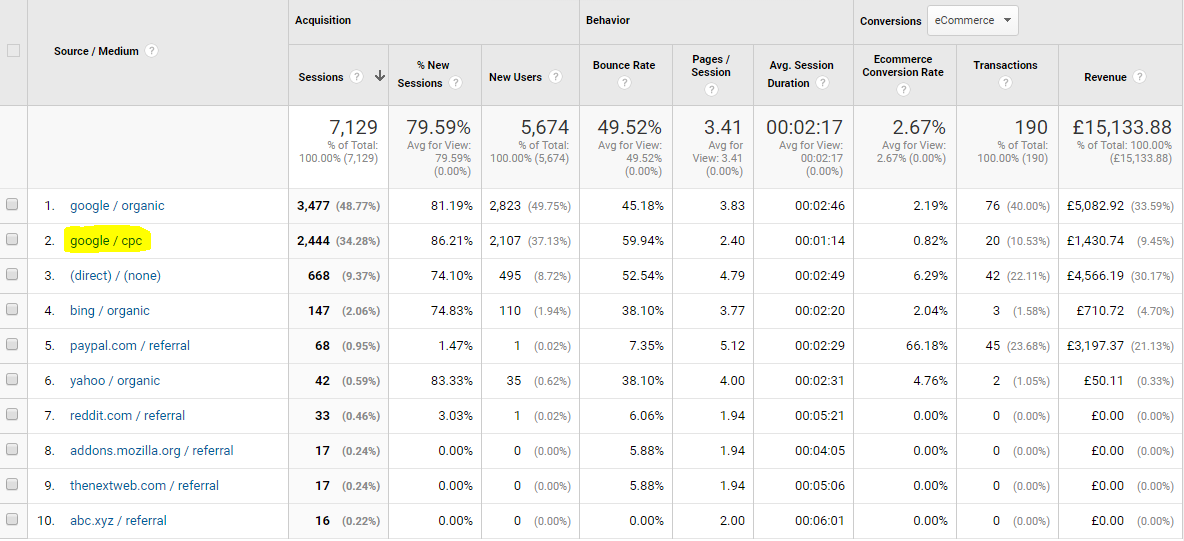
Once sales data is being collected at Analytics level, it can then be imported into Google Ads so you can see the relation between cost per conversion and the revenue generated. The screen grab below show conversion data and revenue, as well as the ration of ad spend to revenue collected. Google Ads is able to show the ROI in multiples whether its a positive or a loss.
In the case below for every £1 spent, the campaign generated £5.38 back. The total cost was £246.62 with a return of £1,325.59

To do this, you’ll need to ensure your Google analytics is collecting website sales data. Then you need to link your Analytics with Google Ads account. Then you need to import the Analytics data into Google Ads. Then you need to format your stats dashboard so you’re able to see the ratio to ad spend.
As you can see, it does get a bit technical with all this linking.
Question: When you log into your Google Analytics and Google Ads, can you see all of this?
Modelling ROI
In our experience, eCommerce businesses convert at different % so its hard to estimate but we can at least attempt it.
What do you think your website converts at? If you’re not sure, how many visits did your website get last month compared to the sales you received. You can then work out your website conversion rate.
2-3% website conversion is a good figure to start with. Let’s take the average of £0.50 a click for the blue suede shoes market.
10 clicks will cost £5 at £0.50 CPC
100 clicks will cost £50
If we model that your website will convert leads at 3% then 100 clicks will gain you 3 sales
Each sale will cost the business £16.66 each. (The cost to advertise and bring in 1 sale)
So already it’s costing the business £50 to get 3 sales at 3% website conversion.
What are the profit values for a sale generated?
Let’s say the margin on blue suede shoes was 50% and the shoe was selling for £50. This means we have a £25 margin room to play with.
Minus the cost of Ads £16.66 per sale leaves you with a profit of £8.34 on each shoe.
The above is the formula we use to “plug in” figures to model scenarios on cold website traffic.
You NEED a model to view the numbers in a probability and mathematical way, to give life to your Google Ads campaign.
Modelling is absolutely important because it gives life to the campaign and to see scenarios. Business owners who invest in Google Ads should see it as testing your way to success.
Test quick to find out what doesn’t work.
Keyword Intention
Google Shopping is primarily keyword driven when it comes to Google searches.
The most important thing when running a Google Shopping campaign is does the keyword that is being triggered have the right intention for the website?
Most companies we work with, they’re driven by and immediate sales from buyers. This means you need to use keywords that reflect the type of customer you’re looking for and the type of interaction you want the website to do.
We must understand or at least try to understand what the person is thinking when they’re using keywords. Let’s take the blue suede shows keywords. Let’s put out a selection of related keywords and lets try to understand their meaning for the blue suede shoes market.
1. blue suede shoes – This searcher wants to consider buying some shoes – 70-80% buying intention
2. blue suede shoes song – This searcher is looking for the song by elvis presley. We don’t want our ads to appear for this
3. what is blue suede shoes – This searcher has little intention of buying and more likely researching right now
4. blue suede shoe for sale – This searcher has 100% buying intention
If you were in a the shoes market and served customers, you would most likely want your ads to appear for keywords 1 and 2 and to a lesser extent number 3.
Monitoring The Competition
There are a couple of ways you can monitor the competition. You can do a basic Google search and see what competitors come up but you can also see how you compare when you’re bidding against your competitors. The screen shot below shows “YOU” which is the clients details. It means they’re showing 40.45% of the time for eligible searches. They have 4 competitors ahead of them which are gaining more clicks than this client (major brands). The following allows us to see whose behind or in front of us.
By using the information below, we can decide if we want to compete or stay consistent. The aim eventually is to be the top shop name in the list to show for ALL eligible impressions.
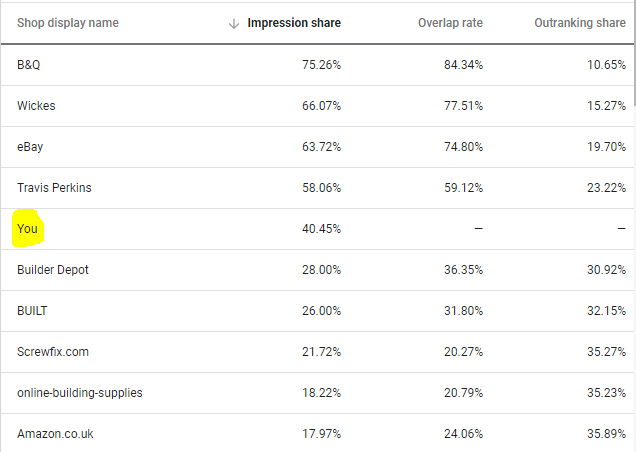
Question – Do you know if your competitors appear more than you? If yes, do you want to compete and get ahead of them?
Keyword Match Types
The great thing about an ecommerce business, you can market using Google shopping and text ads.
Maybe you’re confused, “What is keyword match types?” Let me explain what this means.
Keyword match types is a setting you “apply” to your keywords which tells Google how it will trigger your ads. There are 4 main keyword match types (Think of it as 4 settings which you can apply to a keyword):
- Broad Match
- Phrase Match
- Exact Match
- Broad Match Modifier
The NUMBER 1 reason why users fail with Google Adwords Search is that they use Broad Match keywords right from the get go, meaning they apply broad match settings (by default) and not even know it.
They don’t understand what it means. For most businesses broad match settings is probably the last setting to explore once you’ve gotten ROI from the other 3 settings.
This section is long so I suggest you download this special PDF report here which explains why keyword match types is one of the most important areas to know about Google Ads
Google Ads is NOT the problem
Google Ads doesn’t work for all industries but if an industry is paying a very high cost per click then it means that Google Ads is working for them.
What this means is that Google Ads is not the problem. If the Ads don’t work for a website, the business/website IS the problem, not the Ads.
Here at Click Metrics, we ONLY work with commercial intention keywords because we focus on people that are ready to buy.
We can agree a keywords that has commercial intention. If that person doesn’t convert on the website, the keyword is not the problem, the website is.
At Click Metrics, we can “mark off” all the factors to why the Google Ads side is NOT working but after that has been tweaked, the focus now would be on the website to do the final “lift”.
We can 100% control all the Google Ads factors such as:
Keywords – Commercial intention keywords – “emergency maidstone plumbers”
Location – We can select a local areas for leads. Eg only maidstone leads
CPC – We can control the cost per click to get the click
Negative Keywords – We can ignore generic words like “course”, “vacancy”
Day / Hour of day – We can select the best day to show ads and times
Conversion Tracking – Track phone calls and form submissions
and more
It comes to a point that Google Ads is no longer the problem and maybe the website or the business is. Google doesn’t promise to solve your business lead generation problems.
All it promises to do is send the right targeted click as guided by the practitioner. Google is a connector of people and businesses but you need a bit of skill to use the Ads platform to its full potential. Our job for both of us, is to find out if Google Ads can work for your business very quickly.




